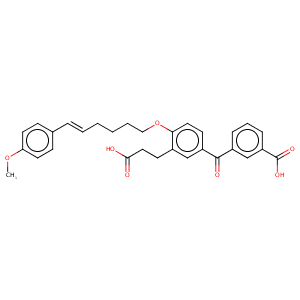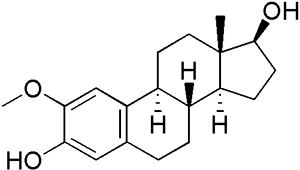| 1 |
Recurrent recessive mutation in deoxyguanosine kinase causes idiopathic noncirrhotic portal hypertension.Hepatology. 2016 Jun;63(6):1977-86. doi: 10.1002/hep.28499. Epub 2016 Mar 31.
|
| 2 |
URL: http://www.guidetopharmacology.org Nucleic Acids Res. 2015 Oct 12. pii: gkv1037. The IUPHAR/BPS Guide to PHARMACOLOGY in 2016: towards curated quantitative interactions between 1300 protein targets and 6000 ligands. (Ligand id: 7873).
|
| 3 |
Clinical Phase I study with an Insulin-like Growth Factor-1 receptor inhibitor: experiences in patients with squamous non-small cell lung carcinoma. Acta Oncol. 2011 Apr;50(3):441-7.
|
| 4 |
IGF-1 receptor tyrosine kinase inhibition by the cyclolignan PPP induces G2/M-phase accumulation and apoptosis in multiple myeloma cells. Blood. 2006 Jan 15;107(2):669-78. doi: 10.1182/blood-2005-01-0306. Epub 2005 Sep 15.
|
| 5 |
Estrogen effects on tubulin expression and taxane mediated cytotoxicity in prostate cancer cells. Prostate. 2005 Oct 1;65(2):141-50. doi: 10.1002/pros.20246.
|
| 6 |
Combination of Quercetin and 2-Methoxyestradiol Enhances Inhibition of Human Prostate Cancer LNCaP and PC-3 Cells Xenograft Tumor Growth. PLoS One. 2015 May 26;10(5):e0128277. doi: 10.1371/journal.pone.0128277. eCollection 2015.
|
| 7 |
2-Methoxyestradiol and paclitaxel have similar effects on the cell cycle and induction of apoptosis in prostate cancer cells. Cancer Lett. 2006 Jan 8;231(1):49-64. doi: 10.1016/j.canlet.2005.01.018.
|
| 8 |
Gastrointestinally distributed UDP-glucuronosyltransferase 1A10, which metabolizes estrogens and nonsteroidal anti-inflammatory drugs, depends upon phosphorylation. J Biol Chem. 2004 Jul 2;279(27):28320-9. doi: 10.1074/jbc.M401396200. Epub 2004 Apr 26.
|
| 9 |
Hypoxia-inducible factor (HIF) inhibitors: a patent survey (2011-2015).Expert Opin Ther Pat. 2016;26(3):309-22.
|
| 10 |
2-methoxyestradiol induces mitotic arrest, apoptosis, and synergistic cytotoxicity with arsenic trioxide in human urothelial carcinoma cells. PLoS One. 2013 Aug 13;8(8):e68703. doi: 10.1371/journal.pone.0068703. eCollection 2013.
|
| 11 |
EGF promotes HIF-1 expression in colorectal cancer cells and tumor metastasis by regulating phosphorylation of STAT3. Eur Rev Med Pharmacol Sci. 2019 Feb;23(3):1055-1062. doi: 10.26355/eurrev_201902_16993.
|
| 12 |
Expression and cyclic variations of catechol-O-methyl transferase in human endometrial stroma. Fertil Steril. 2008 Sep;90(3):789-97. doi: 10.1016/j.fertnstert.2007.01.042. Epub 2007 Apr 5.
|
| 13 |
Arsenic trioxide and 2-methoxyestradiol reduce beta-catenin accumulation after proteasome inhibition and enhance the sensitivity of myeloma cells to Bortezomib. Leuk Res. 2008 Nov;32(11):1674-83. doi: 10.1016/j.leukres.2008.03.039. Epub 2008 May 15.
|
| 14 |
Involvement of peroxiredoxin IV in the 16alpha-hydroxyestrone-induced proliferation of human MCF-7 breast cancer cells. Cell Biol Int. 2008 Apr;32(4):401-5. doi: 10.1016/j.cellbi.2007.12.009. Epub 2008 Jan 10.
|
| 15 |
Sulfotransferase (SULT) 1A1 polymorphic variants *1, *2, and *3 are associated with altered enzymatic activity, cellular phenotype, and protein degradation. Mol Pharmacol. 2006 Jun;69(6):2084-92. doi: 10.1124/mol.105.019240. Epub 2006 Mar 3.
|
| 16 |
The role of 17beta-hydroxysteroid dehydrogenases in modulating the activity of 2-methoxyestradiol in breast cancer cells. Cancer Res. 2006 Jan 1;66(1):324-30. doi: 10.1158/0008-5472.CAN-05-2391.
|
| 17 |
12-O-tetradecanoylphorbol-13-acetate upregulates the Ah receptor and differentially alters CYP1B1 and CYP1A1 expression in MCF-7 breast cancer cells. J Cell Biochem. 1998 Sep 1;70(3):289-96.
|
| 18 |
Acquisition of resistance of pancreatic cancer cells to 2-methoxyestradiol is associated with the upregulation of manganese superoxide dismutase. Mol Cancer Res. 2012 Jun;10(6):768-77. doi: 10.1158/1541-7786.MCR-11-0378. Epub 2012 Apr 30.
|
| 19 |
In vitro model of mammary estrogen metabolism: structural and kinetic differences between catechol estrogens 2- and 4-hydroxyestradiol. Chem Res Toxicol. 2004 Sep;17(9):1258-64. doi: 10.1021/tx0498657.
|
|
|
|
|
|
|


